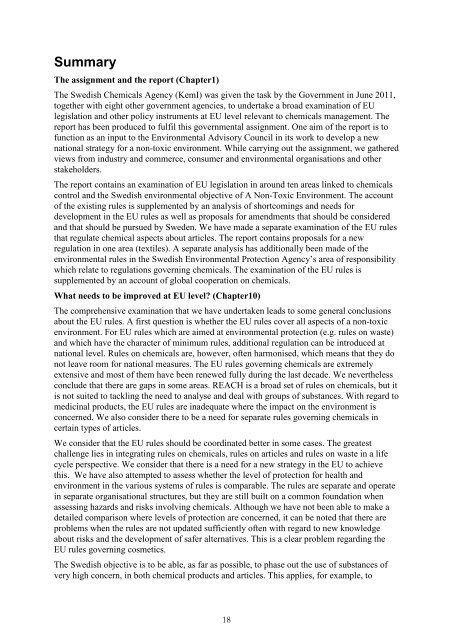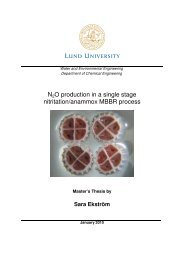Bättre EU-regler för en giftfri miljö - Kemikalieinspektionen
Bättre EU-regler för en giftfri miljö - Kemikalieinspektionen
Bättre EU-regler för en giftfri miljö - Kemikalieinspektionen
You also want an ePaper? Increase the reach of your titles
YUMPU automatically turns print PDFs into web optimized ePapers that Google loves.
Summary<br />
The assignm<strong>en</strong>t and the report (Chapter1)<br />
The Swedish Chemicals Ag<strong>en</strong>cy (KemI) was giv<strong>en</strong> the task by the Governm<strong>en</strong>t in June 2011,<br />
together with eight other governm<strong>en</strong>t ag<strong>en</strong>cies, to undertake a broad examination of <strong>EU</strong><br />
legislation and other policy instrum<strong>en</strong>ts at <strong>EU</strong> level relevant to chemicals managem<strong>en</strong>t. The<br />
report has be<strong>en</strong> produced to fulfil this governm<strong>en</strong>tal assignm<strong>en</strong>t. One aim of the report is to<br />
function as an input to the Environm<strong>en</strong>tal Advisory Council in its work to develop a new<br />
national strategy for a non-toxic <strong>en</strong>vironm<strong>en</strong>t. While carrying out the assignm<strong>en</strong>t, we gathered<br />
views from industry and commerce, consumer and <strong>en</strong>vironm<strong>en</strong>tal organisations and other<br />
stakeholders.<br />
The report contains an examination of <strong>EU</strong> legislation in around t<strong>en</strong> areas linked to chemicals<br />
control and the Swedish <strong>en</strong>vironm<strong>en</strong>tal objective of A Non-Toxic Environm<strong>en</strong>t. The account<br />
of the existing rules is supplem<strong>en</strong>ted by an analysis of shortcomings and needs for<br />
developm<strong>en</strong>t in the <strong>EU</strong> rules as well as proposals for am<strong>en</strong>dm<strong>en</strong>ts that should be considered<br />
and that should be pursued by Swed<strong>en</strong>. We have made a separate examination of the <strong>EU</strong> rules<br />
that regulate chemical aspects about articles. The report contains proposals for a new<br />
regulation in one area (textiles). A separate analysis has additionally be<strong>en</strong> made of the<br />
<strong>en</strong>vironm<strong>en</strong>tal rules in the Swedish Environm<strong>en</strong>tal Protection Ag<strong>en</strong>cy’s area of responsibility<br />
which relate to regulations governing chemicals. The examination of the <strong>EU</strong> rules is<br />
supplem<strong>en</strong>ted by an account of global cooperation on chemicals.<br />
What needs to be improved at <strong>EU</strong> level? (Chapter10)<br />
The compreh<strong>en</strong>sive examination that we have undertak<strong>en</strong> leads to some g<strong>en</strong>eral conclusions<br />
about the <strong>EU</strong> rules. A first question is whether the <strong>EU</strong> rules cover all aspects of a non-toxic<br />
<strong>en</strong>vironm<strong>en</strong>t. For <strong>EU</strong> rules which are aimed at <strong>en</strong>vironm<strong>en</strong>tal protection (e.g. rules on waste)<br />
and which have the character of minimum rules, additional regulation can be introduced at<br />
national level. Rules on chemicals are, however, oft<strong>en</strong> harmonised, which means that they do<br />
not leave room for national measures. The <strong>EU</strong> rules governing chemicals are extremely<br />
ext<strong>en</strong>sive and most of them have be<strong>en</strong> r<strong>en</strong>ewed fully during the last decade. We nevertheless<br />
conclude that there are gaps in some areas. REACH is a broad set of rules on chemicals, but it<br />
is not suited to tackling the need to analyse and deal with groups of substances. With regard to<br />
medicinal products, the <strong>EU</strong> rules are inadequate where the impact on the <strong>en</strong>vironm<strong>en</strong>t is<br />
concerned. We also consider there to be a need for separate rules governing chemicals in<br />
certain types of articles.<br />
We consider that the <strong>EU</strong> rules should be coordinated better in some cases. The greatest<br />
chall<strong>en</strong>ge lies in integrating rules on chemicals, rules on articles and rules on waste in a life<br />
cycle perspective. We consider that there is a need for a new strategy in the <strong>EU</strong> to achieve<br />
this. We have also attempted to assess whether the level of protection for health and<br />
<strong>en</strong>vironm<strong>en</strong>t in the various systems of rules is comparable. The rules are separate and operate<br />
in separate organisational structures, but they are still built on a common foundation wh<strong>en</strong><br />
assessing hazards and risks involving chemicals. Although we have not be<strong>en</strong> able to make a<br />
detailed comparison where levels of protection are concerned, it can be noted that there are<br />
problems wh<strong>en</strong> the rules are not updated suffici<strong>en</strong>tly oft<strong>en</strong> with regard to new knowledge<br />
about risks and the developm<strong>en</strong>t of safer alternatives. This is a clear problem regarding the<br />
<strong>EU</strong> rules governing cosmetics.<br />
The Swedish objective is to be able, as far as possible, to phase out the use of substances of<br />
very high concern, in both chemical products and articles. This applies, for example, to<br />
18















